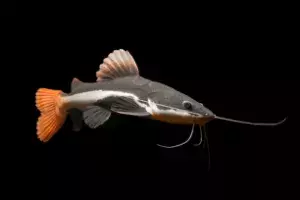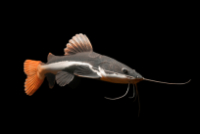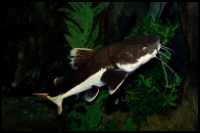





Quick Care Details (Table)
| Livestock Characteristics | Value |
|---|---|
| Care Level | Moderate |
| Temperament | Aggressive |
| Diet | Carnivorous |
| Maximum Size | 4 FT |
| Minimum Tank Size | 500 gallons |
| Plant Safe | No |
| Temperature Range | 75-82°F (24-28°C) |
| PH Range | 6.0-7.5 |
| KH Range | 4-8 dKH |
| GH Range | 6-15 dGH |
Species Specific Categories
Helpful Video
Care Details
Aquascape: Red Tail Catfish require a spacious tank due to their large dimensions. A well-aerated environment with hiding spots and open swimming areas mimics their natural habitat. Large driftwood, rocks, and plants (though they might uproot them) can be included.
Substrate: Smooth gravel or sand is preferable to prevent injury to their barbels (whisker-like sensory organs).
Disease Prevention: Quarantine new additions, maintain good water quality, and avoid overcrowding to minimize stress. Regular water changes are crucial.
Filtration: Powerful filtration is a must due to their large size and high waste production. Canister filters or sumps with mechanical and biological filtration are recommended.
Lighting: Most catfish don't have specific lighting needs, but providing a natural day-night cycle is beneficial.
Water Flow: Moderate to strong water flow is suitable, but ensure it's not too strong to stress the fish.
Hardiness: They're hardy if provided with appropriate tank conditions.
Acclimation: Gradual acclimation to tank water temperature and parameters is essential to reduce stress.
Expected Lifespan: This catfish can live 15-20 years in proper conditions.
Special Requirements: Regular monitoring of tank dimension as they grow rapidly, and a tank cover to prevent jumping.
Temperament and Behavior
Behavior: Mostly nocturnal and can be solitary. This catfish is predatory and can eat tankmates that are small enough to fit in their mouth.
Breeding: Breeding in captivity is rare due to specific environmental cues needed to trigger breeding behavior.
Aggression: Generally peaceful towards larger tankmates but can be aggressive towards smaller ones.
Tankmates Compatibility: Compatible with
larger, robust fish that won't be seen as prey. Tankmates should match their size or be larger to avoid being seen as food.
Activity Level: Typically active during the night and may rest during the day.
Schooling or Shoaling Behavior: This catfish don't display schooling behavior but might appreciate the company of their own species when young.
Plant Compatibility: They might uproot plants due to their size and activity.
Diet and Nutrition
Dry Foods: Accept some pellet and stick foods, but these shouldn't be the sole diet.
Frozen Foods: Enjoy frozen foods like shrimp, krill, and fish fillets.
Live Foods: Thrive on live foods such as feeder fish, but these should be occasional treats due to the risk of disease transmission.
Vegetables: Occasionally accept vegetables like zucchini or cucumber.
Algae: Not a significant part of their diet.
Feeding Schedule: Offer smaller meals a few times a week, adjusting quantity as these catfish grow.
Supplemental Foods: Vitamin-enriched foods or occasional treats like insects.
Tank Parameters
Tank Size: A tank of at least 500 gallons for adults, but larger is often better.
Tank Length and Measurements: A tank that is at least 8 feet long to accommodate their width.
Water Temperature: Around 75-82°F (24-28°C).
pH (Acidity/Alkalinity): pH between 6.0 and 7.5 is suitable.
KH (Carbonate Hardness) & GH (General Hardness): Moderately soft to moderately hard water is tolerated.
Nitrate (NO3) levels: Keep nitrate levels below 40 ppm through regular water changes.
History, Popularity, History and Species Variety Details
The History, Popularity, and Natural Habitat
History: Red Tail Catfish have been in the aquarium trade for some time due to their striking appearance and unique behaviors. They originate from South America, particularly the Amazon and Orinoco river basins.
Popularity: They're popular among experienced aquarists due to their size and impressive appearance, but their massive growth potential requires dedicated and knowledgeable keepers.
Natural Habitat: Found in slow-moving rivers, flooded forests, and backwaters. They prefer areas with vegetation and submerged structures.
Back to topSimilar and Variations of the Species
- Tiger Shovelnose Catfish (Pseudoplatystoma fasciatum): This species has a striking appearance with a similar elongated body and distinctive tiger-like stripes. This catfish requires large tanks and can grow quite large, similar to Red Tail Catfish.
- Piraiba Catfish (Brachyplatystoma filamentosum): Known for its massive size, Piraiba Catfish is another large species found in South America's river systems. They share the need for sizable tanks due to their growth potential.
- Jau Catfish (Zungaro zungaro): Like Red Tail Catfish, the Jau Catfish is a large predatory species found in South American rivers. These catfish require spacious tanks and are known for their impressive size.
- Goonch Catfish (Bagarius yarrelli): This species is found in rivers across South Asia and, while not directly related, shares similarities in size and predatory behavior with Red Tail Catfish.
- Shovel-nosed Catfish (Sorubim lima): These catfish have a unique shovel-like snout and grow to a considerable width, requiring sizable tanks to accommodate their growth.
- Hybrid Variations: While not natural variations, hybridization might occur in captivity between different large catfish species, including Red Tail Catfish, resulting in unique hybrids with various traits from their parent species.
Frequently Asked Questions
How big do Red Tail Catfish get?
These beauties can grow to an impressive size! This catfish can reach up to 4 feet or more in length, making them a significant addition to any tank.
What tank size do they need?
Given their potential size, these catfish require substantial tanks. For a single adult, you'd want a tank of at least 500 gallons, but bigger is better for their well-being.
Are they compatible with other fish?
These catfish can coexist with larger, robust tankmates. However, smaller fish might become a snack due to their predatory nature.
What's their diet like?
They're carnivorous! They love a varied diet, including pellets, frozen foods, and occasional live treats like feeder fish. Make sure to offer a balanced meal plan.
Do they need special care?
Good filtration is a must due to their waste production. Also, monitoring tank dimensions as they grow and providing a secure tank cover to prevent jumping are essential.
Can they live with plants?
They might rearrange your aquascape! Their activity and mass might lead to uprooting plants, so it's wise to choose hardy, rooted plants or skip them altogether.
How long do they live?
With proper care, these catfish can live 15-20 years or even more in the right conditions.
Do they need specific water conditions?
They prefer temperatures around 75-82°F, and a pH range of 6.0 to 7.5 suits them well. Keep an eye on water quality and regular maintenance.
Can they be bred in captivity?
It's quite rare due to the specific environmental cues needed to trigger breeding behavior, making successful breeding a bit challenging.
Are they suitable for beginners?
They're better suited for experienced aquarists due to their size, tank requirements, and need for proper diet and care. Beginners might find their needs a bit challenging to manage.

